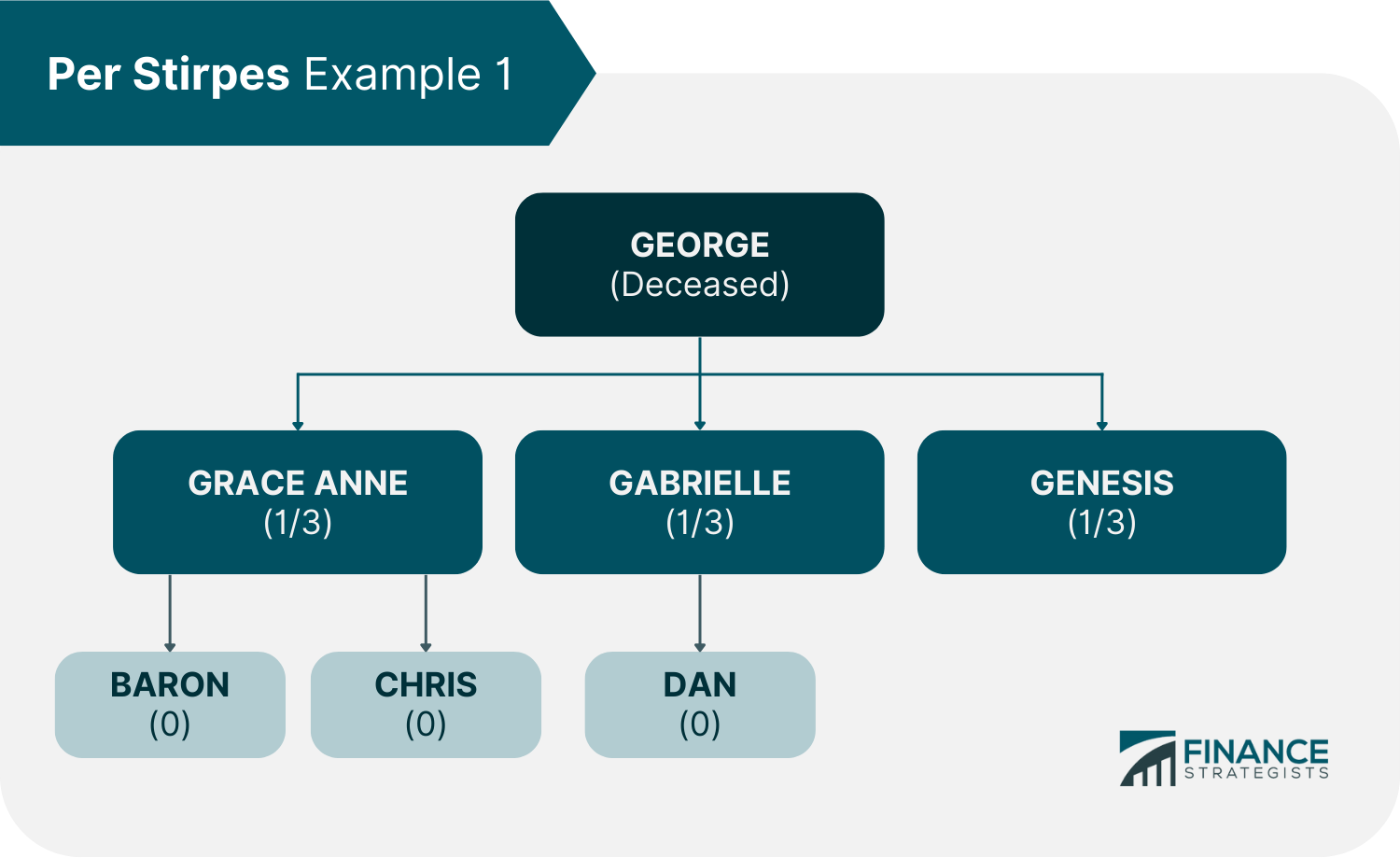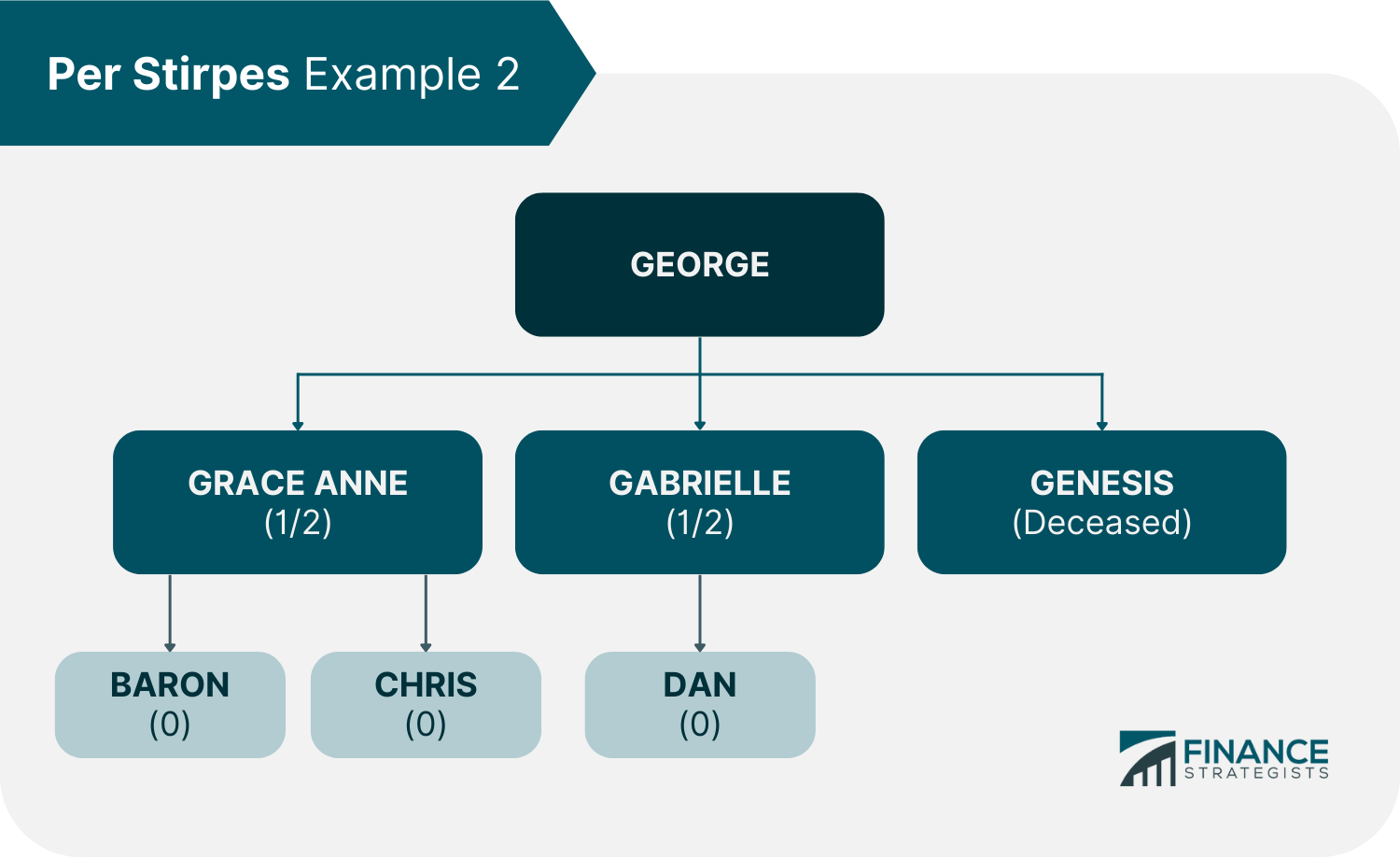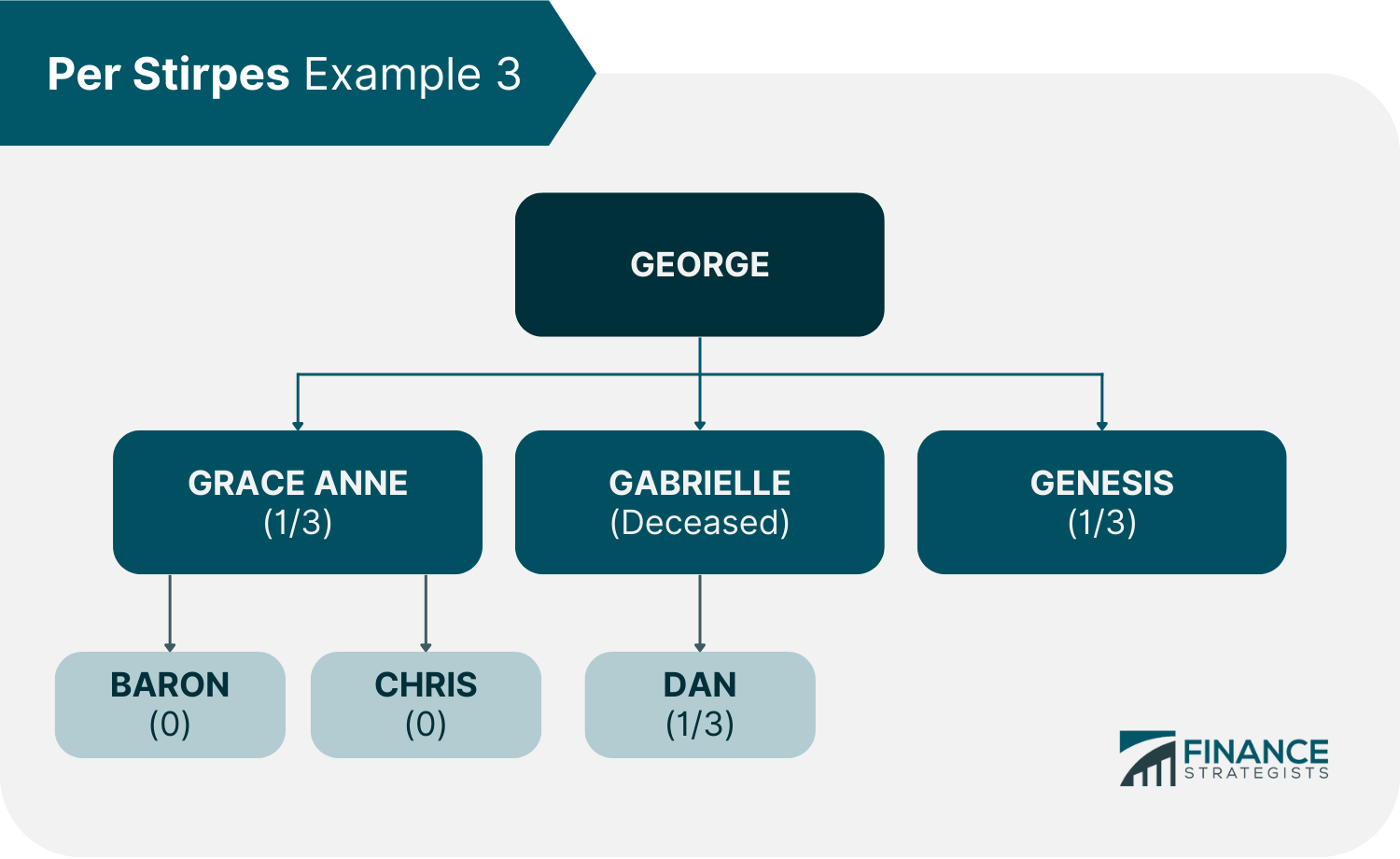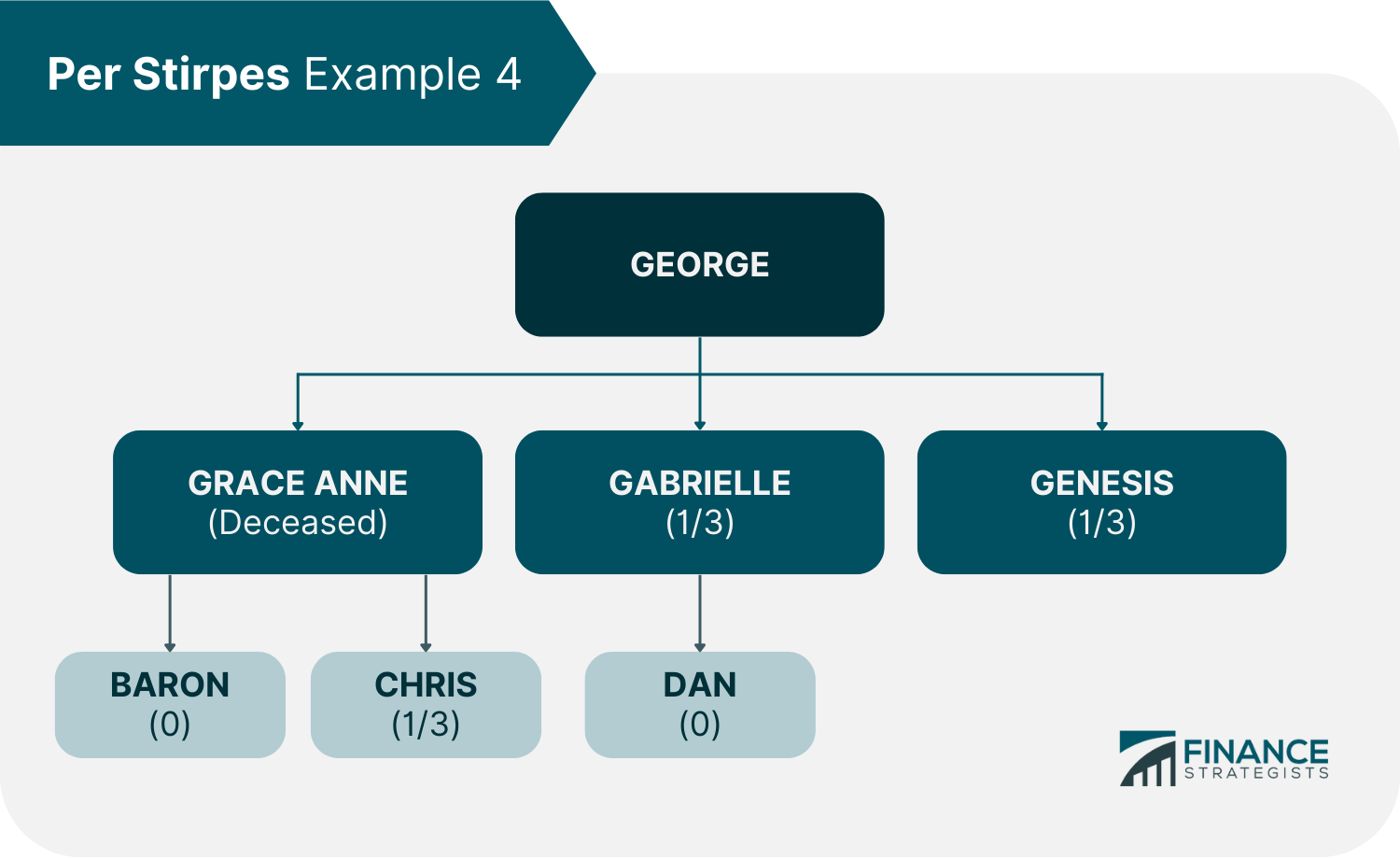What Is Per Stirpes?
Per stirpes is a legal term used in the law governing inheritance and estate.
It is a designation that decrees how the assets of a testator (person making the will) will be distributed when a beneficiary passes away ahead of him.
In such a case, his share will be equally divided among his heirs, usually children.
Per stirpes, as applied in drafting a last will and testament, is the focus of this article.
How Does Per Stirpes Work?
Per stirpes has a Latin origin translated as “by roots” or “by branch.”
It states how your inheritance will be divided if one of your named beneficiaries dies ahead of you.
Per stirpes defines an equal asset distribution for each “branch” of a family tree. Children of the deceased beneficiary may represent their parents. Spouses, however, are not considered in a per stirpes distribution.
Here is a sample application of per stirpes:
“I give to my daughter, Grace Anne, one-half of my estate. If Grace Anne does not survive me, this inheritance should be distributed to her descendants, per stirpes.”
Per Stirpes Examples
Here is a sample scenario to illustrate the application of per stirpes in a will.
George, the testator, has three children: Grace Anne, Gabrielle, and Genesis. He assigns his assets to each of them in equal shares, per stirpes.
Grace Anne has two children: Baron and Chris. Gabrielle has a son, Dan. Genesis, Baron, Chris, and Dan do not have children.
Sample Scenario 1
If George dies, and his three children, Grace Anne, Gabrielle, and Genesis, are alive, each of them will receive one-third of George’s estate. Baron, Chris, and Dan would not have direct shares of George’s estate.

Sample Scenario 2
Genesis dies ahead of his father, George. Grace Anne and Gabrielle will each receive one-half of George’s estate.
Since Genesis has no descendants, there is no need to create a share for him. Baron, Chris, and Dan would not have direct shares of George’s estate.

Sample Scenario 3
Gabrielle dies ahead of her father, George. Grace Anne and Genesis will each receive one-third of George’s estate.
Gabrielle’s son, Dan, will inherit his share by representation. He will get one-third of George’s estate. Baron and Chris would not have direct shares of George’s estate.

Sample Scenario 4
Grace Anne and Baron die ahead of George. Gabrielle and Genesis will each inherit one-third of George’s estate.
Chris will inherit Grace Anne’s share by representation. This means he will receive one-third of George’s estate with no siblings to share it with. Dan would not have direct shares in George’s estate.

Importance of Per Stirpes
Using per stirpes distribution in your will can simplify your estate planning process.
It ensures clarity in the distribution of your inheritance should one of your primary beneficiaries pass away ahead of you.
You do not have to go through naming secondary succession for every possible scenario. Per stirpes designation will execute it for you.
Per Stirpes vs Per Capita
Another designation option is using per capita. Per capita means “by heads.”
This method shares the assets equally among surviving descendants in the same generation nearest the testator.
The shares of the predeceased return to the estate unless the testator specifies that children and grandchildren are equal descendants in his will.
Refer back to Sample Scenario above. If Grace Anne dies ahead of George, per capita designation would mean that Gabrielle and Genesis each inherit one-half of George’s estate.
Baron and Chris would not receive anything unless George specified that children and grandchildren are equal descendants in his will.
With the per capita designation, the testator can specify if his assets will be distributed to his children, grandchildren, or both.
Applying this to the sample scenario, Baron, Chris, Gabrielle, and Genesis would each receive one-quarter of the assets.
Eventually, the testator's decision about the family dynamics and his fondness for family members will help determine whether to use the per stirpes or per capita designation on his will.
The Bottom Line
Leaving a legacy is an opportunity to make an impact that will last long after you die.
It allows you to bless your heirs, children, grandchildren, or chosen beneficiaries with the wealth you have earned throughout your lifetime.
In organizing your will, it is essential to be clear about your intentions. Be specific in communicating your wishes.
Whether you choose per stirpes or per capita, consider the long-term consequences of this decision to those you leave behind.
A comprehensive last will benefits your beneficiaries by ensuring an orderly distribution of assets.
Furthermore, it conveys a legacy of commitment, preparation, and generosity to the very end.
Per Stirpes FAQs
If a beneficiary with no descendants dies ahead of the testator, his share of the inheritance will be split equally between the surviving beneficiaries.
Using per stirpes distribution in your will ensures clarity in the distribution of your inheritance should one of your primary beneficiaries pass away ahead of you. You do not need to name secondary succession for every possible scenario.
Per stirpes defines an equal asset distribution for each “branch” of a family tree. Children of the deceased beneficiary may represent their parents. On the other hand, per capita shares the assets equally among surviving descendants in the same generation nearest the testator. Next in-line generation descendants may inherit shares only if stipulated in the will.
Using per stirpes stipulates how the testator’s estate shall be distributed if a beneficiary dies ahead of him. It is a good idea to be prepared and organized, but ultimately, the testator decides how his assets will be distributed.
Spouses are not considered in per stirpes distribution; only family members within the “branch” of succession.
True Tamplin is a published author, public speaker, CEO of UpDigital, and founder of Finance Strategists.
True is a Certified Educator in Personal Finance (CEPF®), author of The Handy Financial Ratios Guide, a member of the Society for Advancing Business Editing and Writing, contributes to his financial education site, Finance Strategists, and has spoken to various financial communities such as the CFA Institute, as well as university students like his Alma mater, Biola University, where he received a bachelor of science in business and data analytics.
To learn more about True, visit his personal website or view his author profiles on Amazon, Nasdaq and Forbes.











